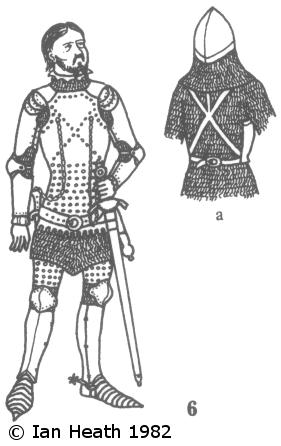
Try Amazon Fresh
RALPH DE KNEVYNTON ESQUIRE d.1370
An extract from Armies of the Middle Ages, Volume 1by Ian Heath



6. RALPH DE KNEVYNTON ESQUIRE d.1370
The armour portrayed here is similar in most respects to that of the last figure. However it is apparent from the arrangement of the rivets on his chest that some development of the coat-of-plates has taken place. From c. 1340 there had been a tendency for the small individual plates protecting the chest to be replaced by a single, larger plate, though the rest of the torso and hips continued to be protected by the smaller plates or else by horizontal hoops passing round the body, usually buckled at the sides and/or back. It is this arrangement which can be seen in Knevynton’s brass. From c. 1370 onwards the breastplate was deepened to reach the top of the hips, still with a skirt or fauld of iron hoops, and by c. 1400 at the very latest it had been joined by a backplate of similar proportions, the two being joined together by buckles down the sides. It was the adoption of breastplates from the mid-14th century on that enabled military men to follow the tight-fitting civilian fashions of dress then in vogue, giving the waspwaisted outline that can be seen in both this figure and others. The Chronicler of St Denis, for instance, complained in 1370 that brigandines were worn ‘so tight-fitting that wearers had to be helped to put them on, and felt as if they were being flayed alive when taking them off’!
It should be noted that the full breastplate appears as a separate piece of armour, independent of the coat-of-plates, considerably earlier, and was often actually worn in conjunction with the coat-of-plates until c. 1380. It is also often to be encountered worn over a mail haubergeon in contemporary illustrations, as depicted in the back view in 6a, where the straps used to hold it in position can be clearly seen.
The adoption of larger plates on the chest, and subsequently of the breastplate, also provided a secure foundation for both a lance-rest (see note 10) and chains attached to the hilts of both sword and dagger to prevent their loss in combat. The use of such chains is seemingly more common in continental sources than in England, Knevynton’s brass being a rare (and fairly certainly foreign) example.
The brass shows Knevynton bareheaded, but a helmet would have obviously been worn in action.